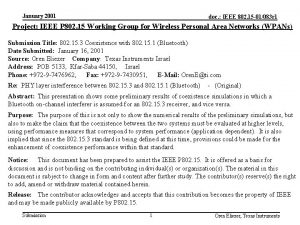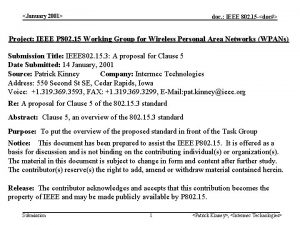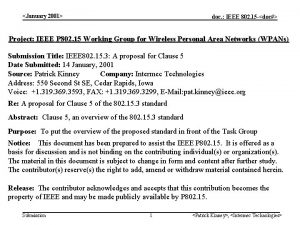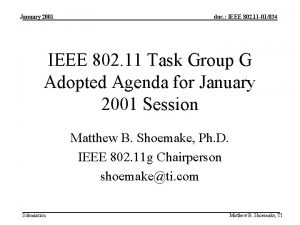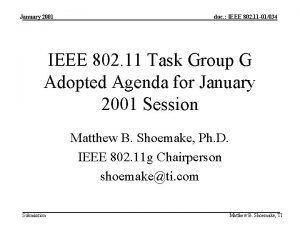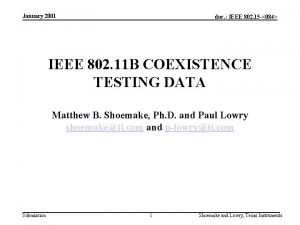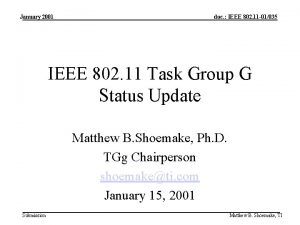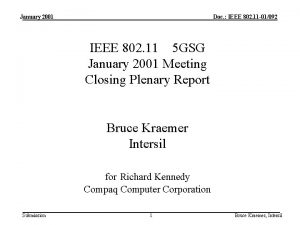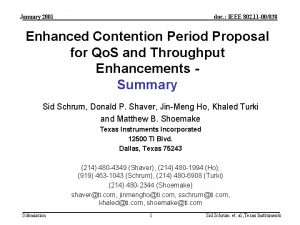January 2001 doc IEEE 802 15 01083 Proposal











- Slides: 11

January 2001 doc. : IEEE 802. 15 -01/083 Proposal for Non-collaborative 802. 11 MAC Mechanisms for Enhancing Coexistence: Adaptive Fragmentation Matthew B. Shoemake, Ph. D. shoemake@ti. com Submission 1 Shoemake, Texas Instruments

January 2001 doc. : IEEE 802. 15 -01/083 Overview • Fragmentation limits the length of packets on the network • Each packet has a finite amount of overhead • If there is no interference, fragmentation reduced the throughput • If there is interference, fragmentation may increased the throughput • This leads to the question: Under what circumstances should fragmentation be enabled and what should the fragmentation level be set to? Submission 2 Shoemake, Texas Instruments

January 2001 doc. : IEEE 802. 15 -01/083 Interference Detection • Many IEEE 802. 11 b solutions estimate the SNR and SINR in the header of each packet • Let G be the set of (SNR, SINR) tuples such that for all (x, y) in G, the probability of having a packet error is small, e. g. p << 1 • Estimate the PER on all packets with (x, y) in G • If the packet error rate is significantly above p, then there must be an interferer in the area that is interfering with the MPDU of the packet • System can then implement mitigation, e. g. fragmentation Submission 3 Shoemake, Texas Instruments

January 2001 doc. : IEEE 802. 15 -01/083 Adaptive Fragmentation • Should adjust length of packet in time to optimize throughput on 802. 11 b networks. • Let – tp be the time taken to transmit a packet – to be the overhead between packets IEEE 802. 11 Packet to tp Submission 4 Shoemake, Texas Instruments

January 2001 doc. : IEEE 802. 15 -01/083 Throughput • Assume when a collision occurs, there is a packet error. Throughput for a given rate is: t. D x r x (1 – p) R= t. H + t. D + t. O • Where t. H is the time for header of the packet, t. D is the time for the data part of the packet, r is the rate of data transmission in the data part of the packet, p is the probability of a packet error, and t. P = t. H + t. D Submission 5 Shoemake, Texas Instruments

January 2001 doc. : IEEE 802. 15 -01/083 Throughput • The flowing values are constant in the BSS: – to is fixed, e. g. at the minimum spacing between frames – t. H is fixed, e. g. long preamble or short preamble plus header • Packet error rate is a function of the length of the packet on the air, so q(tp) can be written Submission 6 Shoemake, Texas Instruments

January 2001 doc. : IEEE 802. 15 -01/083 Throughput Plot For a given data rate and a fixed q(tp), the throughput, R, as a function of tp is well defined Submission 7 Shoemake, Texas Instruments

January 2001 doc. : IEEE 802. 15 -01/083 Optimal Fragmentation • To find the optimal length of each packet analytically, the derivative of R with respect to tp or q(tp) can be taken and set to zero. • Either way the value of dtp/dq or its inverse must be known, and the only way to know this value is to know the function q(tp) • The function q(tp) varies and is not likely to be available in closed form • This implies an adaptive algorithm should be used! Submission 8 Shoemake, Texas Instruments

January 2001 doc. : IEEE 802. 15 -01/083 Adaptive Packet Length Calculation • Let q’ be an estimate of the probability of packet success. This can be measure over some period of time tp, k+1 = tp, k + • Where – Fk = q’(tk) x (tp, k – t. H) / (tp, k + to) – = Fk – Fk-1 Submission 9 Shoemake, Texas Instruments

January 2001 doc. : IEEE 802. 15 -01/083 Performance of Adaptive Scheme Adaptive algorithm find the optimal packet length to optimize throughput after approximately 15 PER estimates. Compare packet length determination with plot on Slide 7 Submission 10 Shoemake, Texas Instruments

January 2001 doc. : IEEE 802. 15 -01/083 Summary • A mechanisms for IEEE 802. 11 b devices to perform adaptive fragmentation calculations is provided. • The optimal fragmentation by the network is determined by the AP via this adaptive algorithm, and the optimal setting is set on the BSS • This algorithm allows for maximization of throughput with by monitoring PER only • This algorithm is compatible with the joint rate shift/power control algorithm proposed in document number TBD. Submission 11 Shoemake, Texas Instruments












